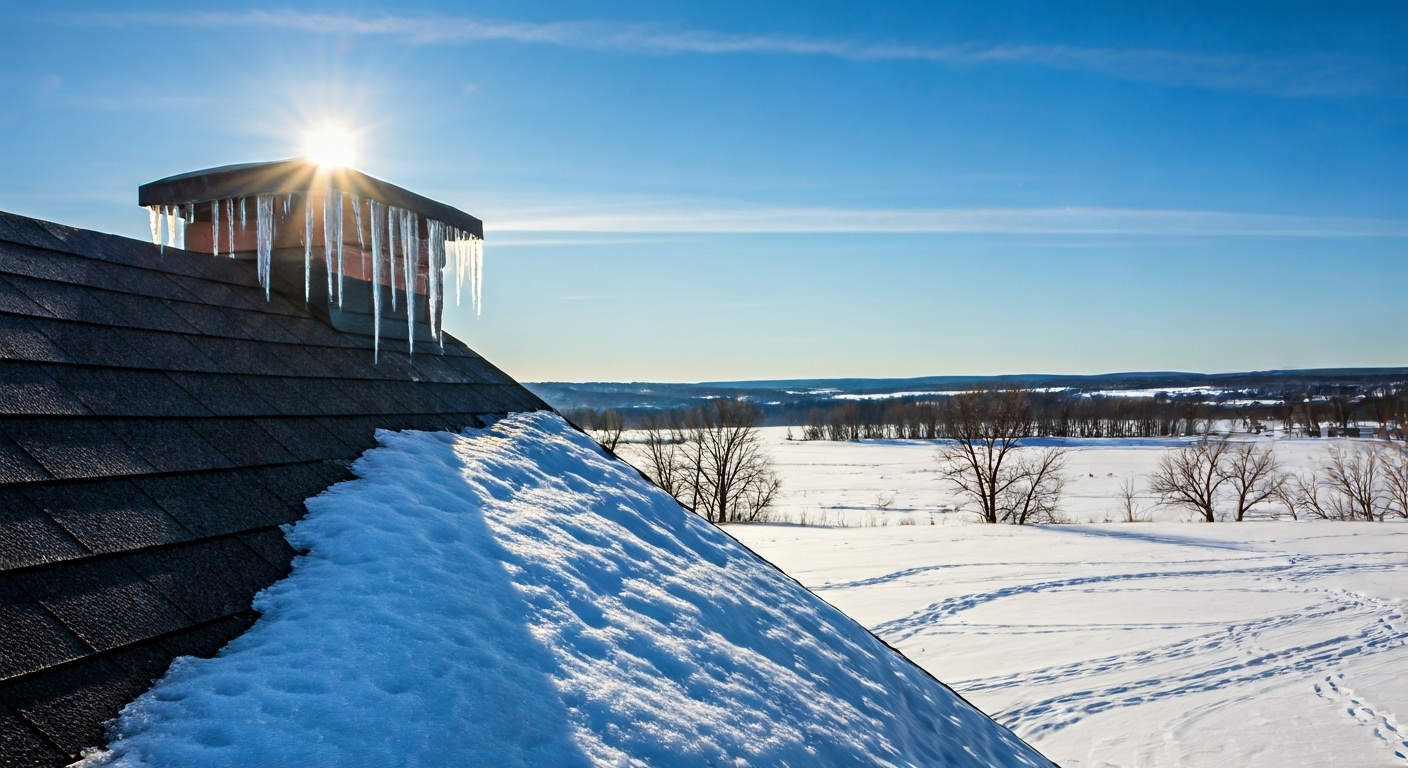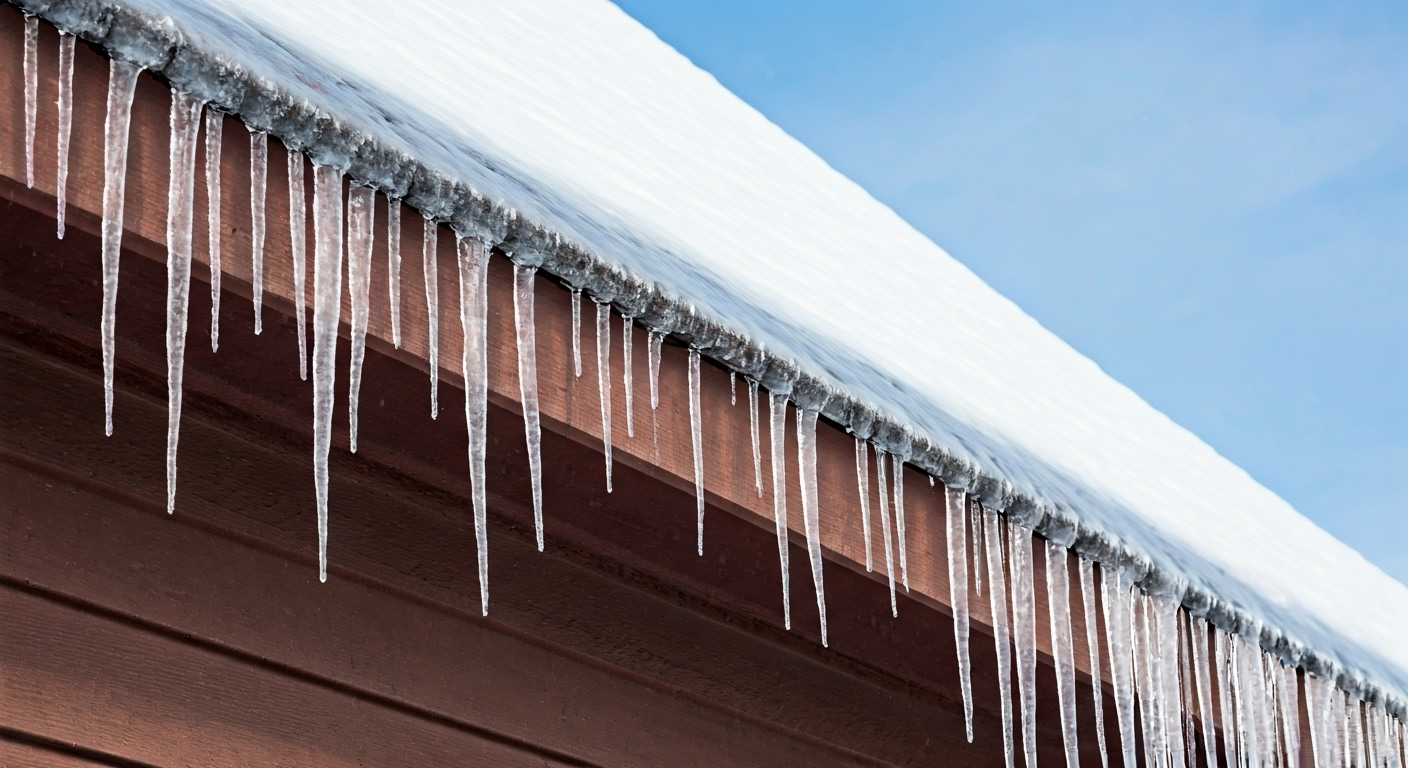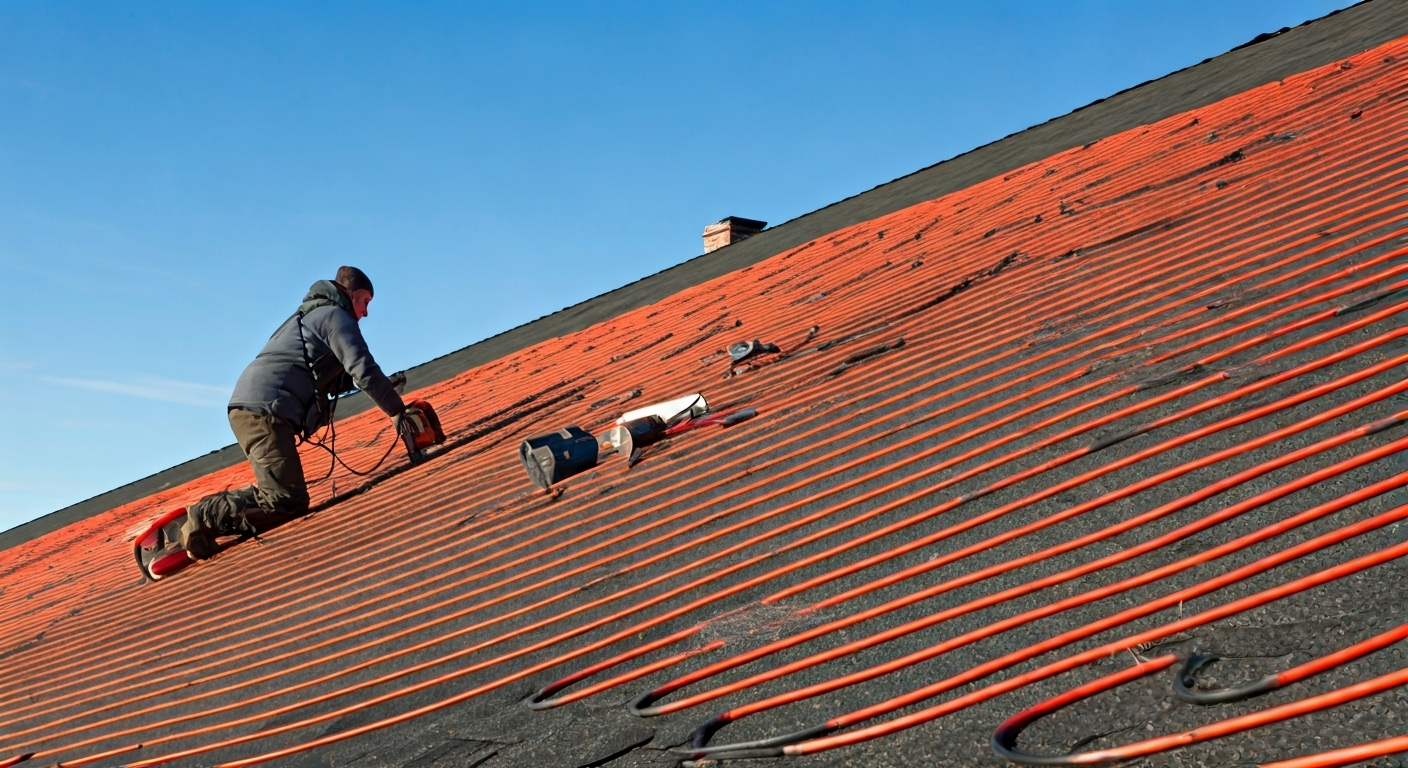How to Stop Ice Dams on Roof: Essential Prevention Tips

Key Highlights of How to Stop Ice Dams on Roof
- Ice dams form when snow melts on a warmer part of your roof and refreezes at colder edges, causing a ridge of ice.
- These ridges trap water, leading to potential water damage in your home, including walls, insulation, and electrical systems.
- Common causes include heat loss, poor attic ventilation, and insufficient insulation.
- Homeowners can prevent ice dams by improving roof ventilation, enhancing attic insulation, and using roof rakes to manage snow.
- Professional services are essential for safe removal and long-term prevention, especially for severe cases.
- Products like heated cables and proper gutter systems provide additional protection.
Introduction
Winter can be beautiful, but it often comes with problems for homeowners, such as ice damming. When snow melts on your roof and then freezes again at the edges, it can make ice dams. These are ridges of ice that stop water from draining off the roof. After some time, this can cause water damage, mold, and problems with the structure of your home. The main reasons this happens are heat loss from your house, poor roof ventilation, or not enough insulation. If you know what causes ice damming, you can stop it from happening to your home. Let’s look at the way to deal with these issues and keep your home safe.
Understanding Ice Dams and Their Impact
Before I discuss how to prevent ice dams on a roof, I want to ensure that you understand what they are and their impacts. Ice dams are more than just a small problem at the edge of your roof. They can put your whole home at risk. An ice dam forms a ridge of ice along the edge of your roof. This blocks the melted snow. The trapped water can get under the shingles. This water then damages your attic, drywall, and even your electrical systems.
If you do not address an ice dam problem, things will only worsen and become more expensive. Mould and mildew love areas with extra moisture and will start to grow. This can cause health problems for you and your family. Addressing the issue early will save you from stress as well as large bills and insurance problems later.
Definition and Formation of Ice Dams on a Roof.
An ice dam is a ridge of ice that sits at the edge of a roof and keeps melted snow from running off. When snow melts on a warm part of your roof and moves down to cold overhangs, it can refreeze. This makes a barrier and traps more water at the edge of the roof or roof eaves. All of this trapped water can start to cause big problems in your home.
The formation of ice dams starts when there is heat loss from inside your home. If warm air gets out through your roof, maybe because there is not enough insulation or ventilation, it warms up the roof’s top. The snow melts on this warm spot, then the water goes to the edge of the roof and refreezes. This continues to add to the ice dam, and the problem worsens.
As time goes by, the ice dam gets bigger. It brings more trouble than just icicles hanging from your eaves or the edge of a roof. There is often a buildup of water, and that water can push up under shingles and roof materials. This allows water to enter your home, potentially damaging your ceilings and walls.
Why Ice Dams on Roofs Are a Concern for Homeowners
Ice dams are not just something ugly on the roof. They can cause serious trouble for your home. The biggest problem you can face is water damage. When water gets trapped behind the ice dam, it can get into the roof underlay and soak the insulation. It might also end up inside the walls of your home.
This water damage is hazardous because it may not be immediately noticeable. Over time, it helps mould and mildew grow in the wet places. These things can make it hard to breathe and cause respiratory problems for you and your family. Fixing these problems can be costly, especially if they reach the drywall or floors.
It’s good for homeowners to take a close look at their home insurance policy. Many of these plans do not cover damage from ice dams. They say it is something you could have stopped with regular care. Once you know about this risk, you will want to stop ice dams from forming. This can save your home and help you worry less.
Identifying the Causes of Ice Dams and How to Stop Ice Dams on Roof
 The primary reason for the ice dam problem is how warm air interacts with your roof. If the attic is not well-insulated or sealed, it allows warm air to move up from the rooms below. It travels through the attic floor and warms up the roof from underneath. Snow on top of the roof starts melting because of this warm air, but before it can run off, it freezes again at the roof’s edge where it is colder.
The primary reason for the ice dam problem is how warm air interacts with your roof. If the attic is not well-insulated or sealed, it allows warm air to move up from the rooms below. It travels through the attic floor and warms up the roof from underneath. Snow on top of the roof starts melting because of this warm air, but before it can run off, it freezes again at the roof’s edge where it is colder.
Using the wrong roofing materials or roofs that do not slope enough also contributes to ice dams. These things can make it hard to clear snow. When you put it all together, warm air, poor attic sealing, and snow on the roof, you get ice dams from melt and re-freeze happening over and over again.
Role of Attic Insulation and Ventilation in the Prevention of Ice Dams
Proper attic insulation and attic ventilation are the main ways to stop ice dam problems. Insulation acts like a barrier. It stops warm air from your home from going up into the attic. If you do not have good insulation, warm air will make the entire roof surface heat up. This can cause the snow on the roof to melt and then freeze again.
Attic ventilation is also important. Good air movement—using things like continuous soffit vents or a box fan—keeps the attic temperature close to the outside air. This helps keep the roof temperatures the same all over the roof, so there is less chance for ice dam to form.
When you have both insulation and attic ventilation working well, your roof stays a steady temperature. This stops the problem of melting and freezing that leads to ice dams. Vents help keep the air moving, too. So, you need both good insulation and ventilation to protect your roof.
The Influence of Roofing Materials and Slope Will Stop Ice Dams on the Roof
The type of materials your roof has and how steep it is both affect how snow builds up and melts. Some roofs, like those with shingles that do not have good insulation, can let off more heat. This heat makes the snow melt faster.
If your roof is flat or has a low slope, it is likely to hold on to more snow. This stops water from draining well. These things can make the formation of ice and the formation of ice dams worse. When snow stays on your roof longer, it can freeze at the edges and cause more trouble.
A roof that has a good design can help lower these risks. A roof with a steep slope lets snow go off the side quickly, so there is less snow that piles up. Using good roofing materials and adding insulation in your attic work together as a strong way to stop the melting and freezing cycle. This helps stop the formation of ice and ice dams on your roof.
How to Stop Ice Dams on Roof: Effective Strategies to Prevent Ice Dams
 Preventing ice dams is always better than fixing them after they happen. The main thing is to keep roof temperatures steady. If you add more insulation and better ventilation in the attic, the roof will stay cold. This lowers how much the snow melting happens so that you have less uneven melting.
Preventing ice dams is always better than fixing them after they happen. The main thing is to keep roof temperatures steady. If you add more insulation and better ventilation in the attic, the roof will stay cold. This lowers how much the snow melting happens so that you have less uneven melting.
There are some easy ways you can stop heavy ice from building up. You could get heated cables or set up continuous soffit vents. These keep the ice from forming too much. Also, using a roof rake often to clear away the snow will stop snow accumulation from getting too high.
If you bring together these steps, like adding good ventilation, more insulation, clearing out snow with a roof rake, or using vents, you go a long way in keeping your roof safe every winter.
Enhancing Roof Ventilation and Insulation
To stop an ice dam from forming, you need to have proper ventilation and insulation in the attic. Roof ventilation systems, such as ridge and soffit vents, let cold air flow in and out, which helps keep the roof cool.
Insulation is also important in this. It keeps warm air inside the house. This helps stop the attic from getting too warm. You should add insulation to the attic floor. Also, you need to seal off leaks around ducts or lighting fixtures. This will block warm air from rising.
If you use both roof ventilation and insulation, the roof will have even temperatures. These methods can help prevent uneven snow melting and make ice dams less likely to form. Using these methods helps reduce the potential damage from ice dams.
Installing Heated Cables and Proper Gutter Systems
Adding heated cables is a good investment to stop ice dams. The cables heat up the edge of the roof, so melting snow keeps moving. This stops water from freezing again and creating a ridge of ice.
A proper gutter system works well with these roof changes. Gutters with drip edges help move water away from your home. Mesh covers for gutters prevent leaves and other debris from blocking water flow.
Quick tips for better prevention:
- Install heated cables along roof edges.
- Use mesh covers to keep gutters free from leaves.
- Install drip edges to direct water properly.
If you use these solutions and also keep up with usual care, ice dam problems should not come back this year.
Professional Solutions for Ice Dam Removal
When ice dams become a problem, it is best to contact Precision Roofing Canada. They can save your roof and your money from more harm. The professional services remove the ice you currently have and examine the cause of it.
One effective method is steam-based treatment. This way, there is less risk to your shingles, and it can take off even tough ice. The team will also check your insulation and ventilation. They want to ensure that the same problem does not recur.
Let the professionals help with these jobs. This is a good way to stay safe and prevent further damage down the line.
When to Call Precision Roofing Canada Professionals for Ice Dam Removal
Some situations need a professional. If you notice water damage, such as stains on the ceiling or water seeping from the walls, you should seek assistance. These signs show that the ice dam problem is too much for DIY fixes.
Early spring is also an important time. Melting snow can bring more moisture into hidden spots and cause damage that you can not see. A professional can take care of the ice dam and also look under your roof for extra safety.
When you hire experts, they use safe ways to remove ice dams. They use steam equipment to get rid of the ice. This will not cause new damage to your roof’s surface.
What to Expect from Precision Roofing Canada Professional Ice Dam Treatment
Precision Roofing Canada Professionals give full ice dam solutions that cover more than just removing ice right away. Here’s what you get:
| Treatment Method | What it Involves |
|---|---|
| Steam Equipment | This method melts ice safely and does not hurt your shingles. |
| Gutter and Roof Inspection | They check for problems with insulation or drainage. |
| Insurance Assistance | They help you record claims for water damage and repair coverage. |
These experts at Precision Roofing Canada also tell you how to stop ice dams for good. That way, your home will stay free from ice dam problems.
Conclusion
To sum up, dealing with ice dams is very important if you want to keep your roof and home safe from harm. You need to know how ice dams form and use good ways to stop them from forming. This will help reduce the likelihood of ice dam trouble. Ensure your insulation and ventilation are in good condition. You may also get help from a pro if you need it. The steps you take now can save you money, stress, and time later on. If you have ice dam problems or have questions, call Precision Roofing Canada. We are here to help you with great roofing work. You can call or text us at (613) 404-7805 for help you can trust!
Frequently Asked Questions
What are the immediate steps to take if I spot an ice dam?
First, use a roof rake to quickly remove snow and minimize snow accumulation. Do not attempt to break the ice with tools or your hands, as this can damage the roof surface. Instead, use heated cables or other methods to provide direct warmth, helping to melt the ice safely. You should not attempt to fix extremely severe cases on your own. Get help from a professional if the problem is serious.
Can ice dams cause long-term damage to my roof?
Yes, ice dams can damage your roof and affect its long-term performance. When ice forms, it keeps moisture on your roof. This moisture can weaken shingles. It can also let mold or mildew grow and can damage insulation. After a while, this could mean you will have to pay a lot for repairs. Therefore, it is essential to take preventive measures early to protect your roof from damage.
Call or text Precision Roofing Canada! (613) 404-7805
380 Sweet Grass Circle,
Ottawa, ON K2J 5W9
Facebook | Google Business Page | YouTube | Contact Us | Blogger | IKO Roofing Products |